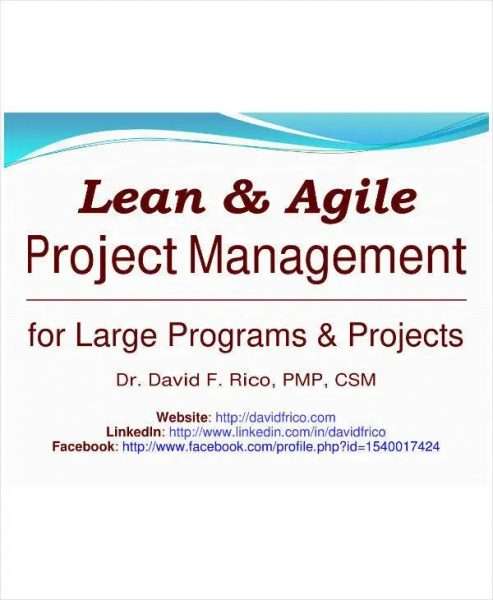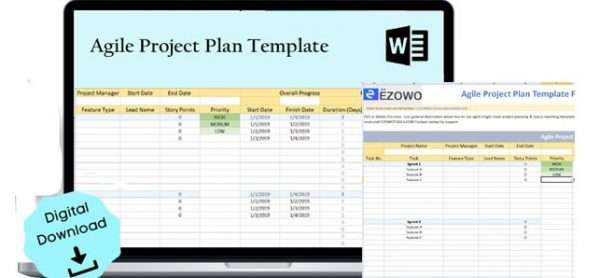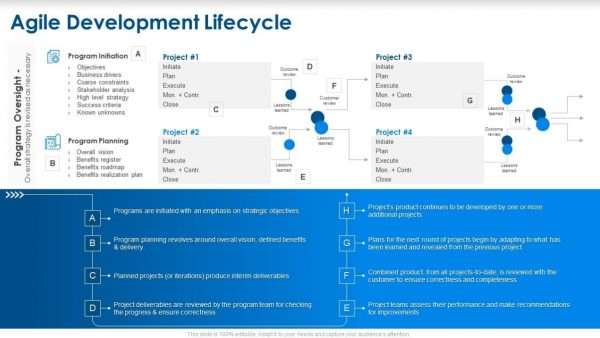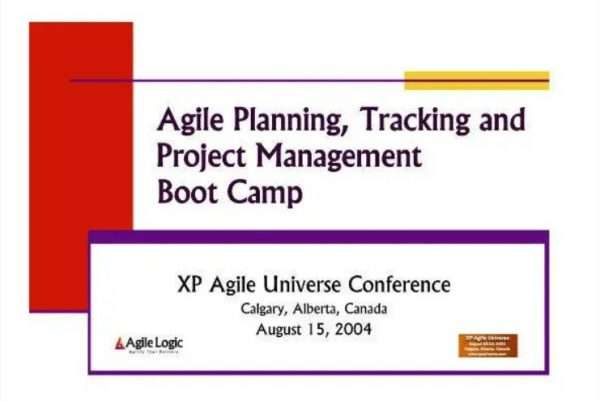You can use a number of different project management tools to set up a new Agile project, and Agile project plan templates are among such tools. An Agile project plan template can be changed and used as a structure for all future Agile projects. The project planning process is sped up, and consistency in project organization is guaranteed when you use an Agile project plan template.
There are some tried-and-true ways to manage the project, such as the waterfall and linear methods. These methods don’t work as well for projects with a lot of uncertainty, like software development. The agile approach was created in 2001 to make it easier to manage projects that change quickly. This method lets fast-paced teams iterate quickly while focusing more on what the client wants.
Difference between agile and traditional planning
The traditional method for planning projects is based on a set cycle: starting, planning, executing, monitoring, and ending. This traditional way of managing projects puts a lot of weight on priorities, planning ahead, documentation, and following steps in order.
While agile project planning focuses on breaking down long tasks into smaller chunks of time called “sprints,” iteration is a key component in agile project management. This indicates that after every sprint or iteration, the team spends some time considering how things might be made better for the next sprint.
There are some other types of Agile methodologies, such as Scrum, Kanban, and Lean development, and Agile project plans can be used in any type of methodology.
5 reasons why the Agile project plan template is important
An Agile project plan template is very helpful for the whole team, not just the product owners or project managers. The following are some reasons for developing an Agile project plan template:
- Gives you a framework to use as a guide as the project moves through each stage of completion.
- Eliminate bottlenecks, stay away from waste, save expenses where you can, and keep improving your development process.
- Short-term objectives, providing value, and attending to the requirements of the consumer are its main concerns.
- Highlights the harmony between humans and technology.
- Make sure that procedures are effective and that communication is clear so that everyone can comprehend their responsibilities and carry them out as quickly as possible.
Agile Project Plan Template Word
Agile Project Plan Template Google Sheets
The agile project management process has five main steps, and the sixth step is a reminder to go back to step 1.
8 agile project management steps

Define a sprint
Defining the sprint is the first step. The aim, objectives, and outcome of the sprint should be included. You should only identify the first sprint at this stage, but having a general idea of the first several sprints will help you decide where and when to draw the line.
Develop the sprint plan
The next stage is to develop a sprint plan and go into further depth. In this stage, the following questions are addressed:
- What are the results that are expected?
- What is the schedule?
- Will you do a daily stand-up?
- What means of communication are you planning to employ?
- How soon should collaborators respond?
- How will you update stakeholders on your progress?
Any tools or additional resources you will need to finish and release these deliverables should also be included in the project scope. You might also want to say who will be in charge of what and how the sprint will be approved.
Establish the sprint deliverables.
You’ll then establish the sprint. That might include any kind of labor, including designing, writing, organizing an event, or coding, depending on the project. During this phase, the project manager should continue to be the main point of contact for all partners and adjust the resources and timelines based on what’s happening in the real world.
Sprint deployment/release
In this step, it’s time to start the sprint. This might include rolling out a new feature to a select group of users, launching a landing page, holding a live webinar, putting a new HR software into use, beginning a new operational process, or carrying out any other kind of launch.
Analyze the sprint.
Analyzing the outcomes and progress is always the last stage of a sprint in a sprint retrospective. The following checks should be tracked and reported on:
- Whether the sprint achieved its set objectives
- Compared to the anticipated budget, the project budget
- Project’s progress in relation to expectations
- Any difficulties that were experienced and how they were resolved
- Positive comments from clients, partners, or stakeholders
- Lessons learned and their implications for the next sprint
Repeat step 1 to begin a new sprint.
For every subsequent sprint, repeat steps 1–5. Continue to make the project’s goals and scope clear, assign tasks, check on progress, and talk about any lessons learned or results.
How to Agile Project Plan
Making a plan that will direct your decisions is a good idea before carrying out the fundamental phases of the agile project management approach. A project management strategy for agile projects should include:
- Project objectives
- Prefered project schedule
- Project collaborators and stakeholders
- Sprint breakdown structure
- Project cost
- Required tools and resources for the project
- Establish project success criteria
- Communication and collaboration techniques
This section should give an overview of the project and explain how you plan to make it work. You will not need to dive deep into tasks and deliverables, since this will be handled in the sprint processes outlined above.
A project management tool or template may be used to record your plan. The best tools and templates are listed below for you to try.
Agile Project Plan Template Excel
4 Characteristics you should know about an Agile Project Plan
Before making an agile project plan using any agile methodology, such as Scrum, Kanban, or Gantt charts, it is essential to know about the basics of an agile project plan template. Here are four characteristics that a good agile project plan has:
1. Inclusion of releases and sprints
Planners who use the agile method says that a “release” is the creation of a new product or a major update to an existing product. Each release is divided into multiple iterations referred to as “sprints.” Each sprint lasts for a certain amount of time, usually two weeks, and the project team is given a list of tasks to do during each sprint.

2. User story-based planning
A good agile project plan includes user stories, which are the items that address user requirements. Story mapping is another part of an agile plan. This is where new products or new features for existing products are laid out.
3. Team members-based estimation
One of the most important rules of agile planning is that team members, not management, should plan and estimate the scope of the work. During this phase of agile planning, teams might figure out how hard the user stories they need to carry out a plan are. In the agile method, a “story point” is the way to figure out how hard a piece of work is.
4. Incremental and iterative planning
In an agile project plan, procedures are defined step by step, and an agile team repeats the same procedure over and over again during each sprint, which is the same length each time. Each sprint ought to produce functional features that may be released to end users.
An iterative method lets the team figure out what they can do, estimate how many stories they can finish in a certain amount of time, and find problems that are holding them back. The solutions to these issues may be found in later sprints.
Agile Project Plan Template Powerpoint
Agile Project Plan Template Online Tools
Click Up:
You can create useful documents like project plans, project reports, and other documents with ClickUp. You may organize them all in ClickUp and attach them to activities. Google Docs-style editing and collaboration with team members are also supported.
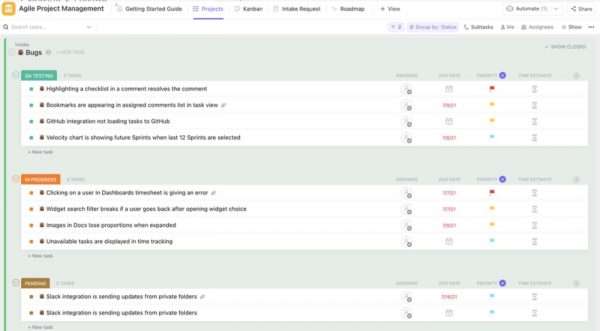
Asana:
Asana is like other tools for managing projects that help teams plan, organize, and carry out tasks. It serves as the ideal support system for navigating chaos and meeting deadlines. It is a cloud-based task collaboration and management solution that unifies all activities and gets rid of email chaos.

Wrike:
Wrike is an extra program for managing projects that help keep track of multiple teams and projects. Its main features include the ability to work with teams outside of your own, an interactive interface, and Kanban boards.
Additionally, Wike can keep track of the time spent on a project to assist with billing and client reports.

Zoho Sprints:
Transparency is the primary goal of Zoho Sprints. Their program is set up so that there is a schedule, a status report, and time between each activity. This is done in an effort to cut out wasteful operations and get a realistic idea of how long an activity takes.

Three Advantages of Online Tools
- Project visualization in different styles:
A digital project management tool allows a product owner to look at the project in different ways, such as a list view, Gantt chart view, calendar view, workload view, and board view. It helps the product owner a lot to examine the current project’s progress and status.
- Data reporting automation:
Some online project management programs can automatically make graphs and charts, such as burndown charts. By doing so, project managers may save time and aid Agile teams in understanding how much work has to be done by the development team before a sprint is completed.
- Real-time project team collaboration:
With digital project management apps, you can set the task duration and details, assign tasks to the project team, and make a master schedule in real-time.
Agile Project Plan Template Miro
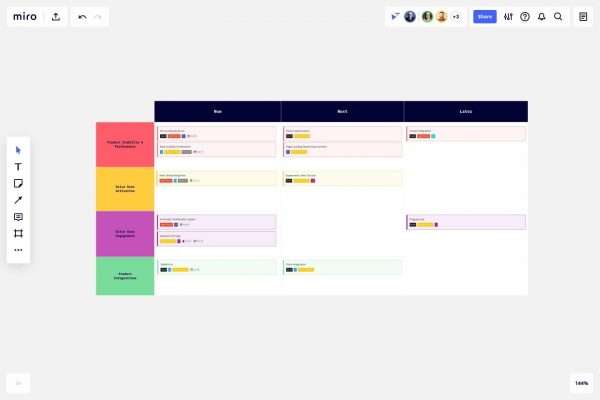
Agile Project Plan FAQs
Should I use a digital agile project plan template?
Absolutely! An Agile project plan template simplifies the process of developing an Agile project. Simply by clicking a few buttons, your team’s customized Agile framework will be live and ready to be used on the next project. Putting the work in the backlog is the first step in launching an Agile project.
What is an Agile project plan called?
Agile project management is an iterative method of organizing and directing project activities. An Agile project is done in manageable portions, just like Agile software development. Iterations are the term for these portions.
What are examples of agile projects?
Agile project management examples are:
– Lean development
– Extreme Programming (XP)
– Scrum



